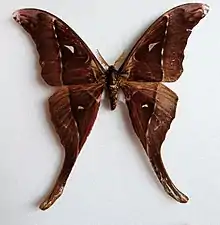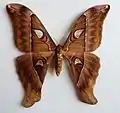| Coscinocera hercules | |
|---|---|
 | |
| Mounted male | |
| Scientific classification | |
| Domain: | Eukaryota |
| Kingdom: | Animalia |
| Phylum: | Arthropoda |
| Class: | Insecta |
| Order: | Lepidoptera |
| Family: | Saturniidae |
| Genus: | Coscinocera |
| Species: | C. hercules |
| Binomial name | |
| Coscinocera hercules Miskin, 1876 | |
Coscinocera hercules, the Hercules moth, is a moth of the family Saturniidae, endemic to New Guinea and northern Australia. The species was first described by William Henry Miskin in 1876.
Description
Adults have a wingspan of about 27 centimetres (11 in), making it the largest moth found in Australia, and its wings have the largest documented surface area (300 square centimeters) of any living insect.[1][2] They are mainly colored golden-brown and white, with transparent spots on each of the four wing sections – the coloring and patterns between sexes is mostly static. However, adult males have longer, slimmer tails on their wings than females do, making it somewhat easy to differentiate them in this way.[3]
Their larvae grow up to 12 cm (about 4.7 in), and will weigh around 54 grams in their final instar.[3] They are a pale-blue or green color, with red dots along their sides and yellow spines.[4]
Diet
As an adult, the Hercules moth does not eat.[5] The larvae feed on the leaves of a number of rainforest trees including Dysoxylum mollissimum, Glochidion ferdinandi, Homalanthus populifolius, Polyscias elegans, Timonius rumphii, and Timonius singularis.[6][7]
 Mounted Female
Mounted Female Larva
Larva
References
- ↑ Robert G. Foottit & Peter H. Adler. 2009. Insect Biodiversity: Science and Society. Blackwell Publishing Ltd. ISBN 978-1-405-15142-9
- ↑ Rainier Flindt. 2006. Amazing Numbers in Biology. Springer-Verlag, Berlin. ISBN 3-540-30146-1
- 1 2 "Saturniidae family". CSIRO Entomology. Commonwealth Scientific and Industrial Research Organisation. Retrieved 14 April 2023.
- ↑ "Hercules Moth: Identification, Life Cycle, Facts & Pictures". Moth Identification. 2020-10-09. Retrieved 2021-04-15.
- ↑ "Hercules, the moth of myth". Minibeast Wildlife. Retrieved 14 April 2023.
- ↑ "Coscinocera hercules". Coffs Harbour Butterfly House. Retrieved 14 April 2023.
- ↑ "The Hercules Moth: The Moth That Doesn't Eat". Australian Butterfly Sanctuary. Retrieved 2021-04-15.
External links
- Information about this species at the Atlas of Living Australia.
- View sightings of this species on iNaturalist.
- View images of this species on Flickriver.com.